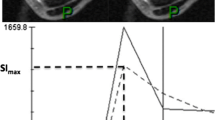Abstract
Objective
To evaluate whether the presence of a feeding vessel in proximity to osteoid osteomas of long bones on multidetector CT (MDCT) can be an adjuvant clue for the diagnosis of osteoid osteoma.
Materials and methods
Forty-nine CT scans of patients with radiological and clinical diagnosis of osteoid osteoma of long bones and a control group of 20 CT scans of patients with cortical-based lesions other then osteoid osteoma were analyzed. Two radiologists evaluated the CT images in consensus for the presence of a blood vessel in the same axial slices in which the nidus of osteoid osteoma was seen and to determine the incidence.
Results
In 39 cases (79.6%) of osteoid osteoma, a blood vessel either entered the nidus (23 patients) or was seen in proximity to it (16 patients). This was significantly different (P < 0.05) from the cortical-based lesions, in which only two CT scans (10%) showed a blood vessel in the lesion’s proximity.
Conclusion
In the majority of osteoid osteoma lesions in long bones, a blood vessel can be seen on MDCT either entering the nidus itself or in its proximity. The role of this vessel in the lesion pathogenesis and whether it improves diagnostic accuracy need further evaluation.

Similar content being viewed by others
References
Lee EH, Shafi M, Hui JH. Osteoid osteoma: a current review. J Pediatr Orthop. 2006;26(5):695–700.
Frassica FJ, Waltrip RL, Sponseller PD, Ma LD, McCarthy Jr EF. Clinicopathologic features and treatment of osteoid osteoma and osteoblastoma in children and adolescents. Orthop Clin North Am. 1996;27(3):559–74.
Golding JS. The natural history of osteoid osteoma; with a report of twenty cases. J Bone Joint Surg Br. 1954;36(2):218–29.
Jaffe H. "Osteoid-osteoma"—a benign osteoblastic tumour composed of osteoid and atypical bone. Arch Surg. 1935;31:709–28.
Hosalkar HS, Garg S, Moroz L, Pollack A, Dormans JP. The diagnostic accuracy of MRI versus CT imaging for osteoid osteoma in children. Clin Orthop Relat Res. 2005;433:171–7.
Bassi P, Piazza P, Cusmano F, Menozzi R. The role of computerized tomography in the diagnosis of osteoid osteoma. Radiol Med (Torino). 1988;75(5):470–5.
Gamba JL, Martinez S, Apple J, Harrelson JM, Nunley JA. Computed tomography of axial skeletal osteoid osteomas. AJR Am J Roentgenol. 1984;142(4):769–72.
Assoun J, Richardi G, Railhac JJ, et al. Osteoid osteoma: MR imaging versus CT. Radiology. 1994;191(1):217–23.
Zampa V, Bargellini I, Ortori S, Faggioni L, Cioni R, Bartolozzi C. Osteoid osteoma in atypical locations: the added value of dynamic gadolinium-enhanced MR imaging. Eur J Radiol. 2009;71(3):527–35.
von Kalle T, Langendorfer M, Fernandez FF, Winkler P. Combined dynamic contrast-enhancement and serial 3D-subtraction analysis in magnetic resonance imaging of osteoid osteomas. Eur Radiol. 2009;19(10):2508–17.
Liu PT, Chivers FS, Roberts CC, Schultz CJ, Beauchamp CP. Imaging of osteoid osteoma with dynamic gadolinium-enhanced MR imaging. Radiology. 2003;227(3):691–700.
Becce F, Theumann N, Rochette A, et al. Osteoid osteoma and osteoid osteoma-mimicking lesions: biopsy findings, distinctive MDCT features and treatment by radiofrequency ablation. Eur Radiol. 2010;20(10):2439–2446
Lindbom A, Lindvall N, Soderberg G, Spjut H. Angiography in osteoid osteoma. Acta Radiol. 1960;54:327–33.
Gilday DL, Ash JM. Benign bone tumors. Semin Nucl Med. 1976;6(1):33–46.
Goto T, Shinoda Y, Okuma T, et al. Administration of nonsteroidal anti-inflammatory drugs accelerates spontaneous healing of osteoid osteoma. Arch Orthop Trauma Surg. 2010;doi:10.1007/s00402-010-1179-
Kneisl JS, Simon MA. Medical management compared with operative treatment for osteoid-osteoma. J Bone Joint Surg. 1992;74(2):179–85.
Simon MA. Percutaneous radiofrequency coagulation of osteoid osteoma compared with operative treatment. J Bone Joint Surg. 1999;81(3):437–8.
Rosenthal DI, Hornicek FJ, Wolfe MW, Jennings LC, Gebhardt MC, Mankin HJ. Percutaneous radiofrequency coagulation of osteoid osteoma compared with operative treatment. J Bone Joint Surg. 1998;80(6):815–21.
de Chadarevian JP, Katsetos CD, Pascasio JM, Geller E, Herman MJ. Histological study of osteoid osteoma’s blood supply. Pediatr Dev Pathol. 2007;10(5):358–68.
Mullin DM, Rodan BA, Bean WJ, Sehayik S, Sehayik R. Osteoid osteoma in unusual locations: detection and diagnosis. South Med J. 1986;79(10):1299–301.
Gil S, Marco SF, Arenas J, et al. Doppler duplex color localization of osteoid osteomas. Skeletal Radiol. 1999;28(2):107–10.
O’Hara 3rd JP, Tegtmeyer C, Sweet DE, McCue FC. Angiography in the diagnosis of osteoid-osteoma of the hand. J Bone Joint Surg. 1975;57(2):163–6.
de Berg JC, Pattynama PM, Obermann WR, Bode PJ, Vielvoye GJ, Taminiau AH. Percutaneous computed-tomography-guided thermocoagulation for osteoid osteomas. Lancet. 1995;346(8971):350–1.
Gangi A, Dietemann JL, Guth S, et al. Percutaneous laser photocoagulation of spinal osteoid osteomas under CT guidance. AJNR Am J Neuroradiol. 1998;19(10):1955–8.
Hayes CW, Conway WF, Sundaram M. Misleading aggressive MR imaging appearance of some benign musculoskeletal lesions. Radiographics. 1992;12(6):1119–34. discussion 1135–1116.
Harish S, Saifuddin A. Imaging features of spinal osteoid osteoma with emphasis on MRI findings. Eur Radiol. 2005;15(12):2396–403.
Conflict of interest
The authors declare that they have no conflict of interest. Authors have nothing to disclose. The study was not financed or supported by any commercial body.
Author information
Authors and Affiliations
Corresponding author
Additional information
Gal Yaniv and Noga Shabshin contributed equally to this article
While our paper was being reviewed, a similar observation was published by Liu et al. in AJR 2011;196(1):168–73.
Rights and permissions
About this article
Cite this article
Yaniv, G., Shabshin, N., Sharon, M. et al. Osteoid osteoma—the CT vessel sign. Skeletal Radiol 40, 1311–1314 (2011). https://doi.org/10.1007/s00256-011-1150-2
Received:
Revised:
Accepted:
Published:
Issue Date:
DOI: https://doi.org/10.1007/s00256-011-1150-2




